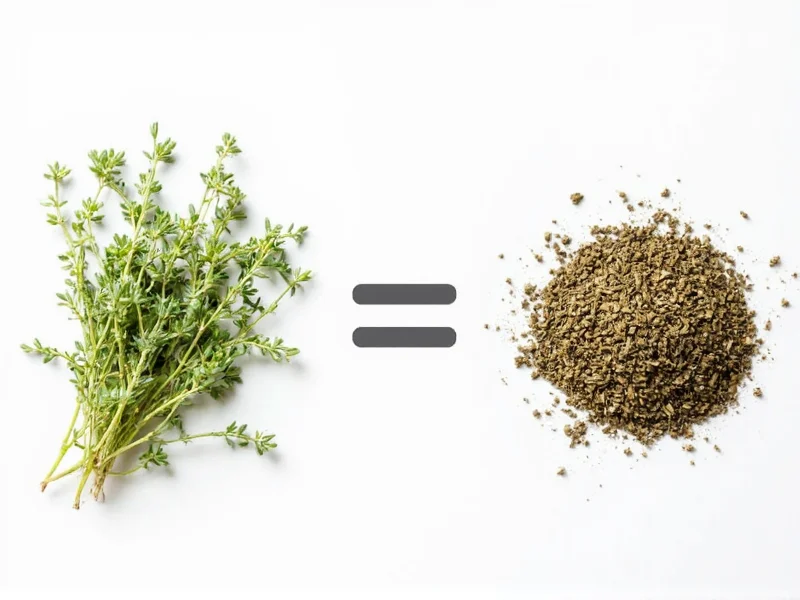4 sprigs of fresh thyme equals approximately 1 teaspoon of dried thyme. This conversion follows the standard 3:1 ratio for fresh-to-dried herb substitution, where dried herbs are typically three times more concentrated than their fresh counterparts.
When converting fresh thyme to dried in your recipes, understanding the precise measurement ensures your dishes maintain the intended flavor profile. This guide provides accurate conversion methods, explains why the ratio exists, and offers practical substitution tips for home cooks and professional chefs alike.
Understanding Fresh to Dried Thyme Conversion
The 3:1 conversion ratio between fresh and dried herbs exists because the drying process concentrates the essential oils and flavors. Fresh thyme contains significant moisture that evaporates during drying, resulting in a more potent dried product. For thyme specifically:
- 1 sprig of fresh thyme yields approximately 1/4 teaspoon of fresh thyme leaves
- 4 sprigs of fresh thyme contain roughly 1 teaspoon of fresh thyme leaves
- Applying the 3:1 ratio: 1 teaspoon fresh thyme = 1/3 teaspoon dried thyme
However, in practical cooking scenarios, most culinary professionals round this measurement to 1 teaspoon of dried thyme for 4 sprigs of fresh thyme to simplify recipe execution while maintaining appropriate flavor intensity.
Accurate Measurement Techniques
Proper measurement technique significantly impacts your conversion accuracy. Follow these steps for reliable results:
- Measuring fresh thyme sprigs: A standard sprig is approximately 4-6 inches long with leaves intact. Strip leaves from the stem before measuring when precision matters most.
- Measuring dried thyme: Spoon dried thyme into your measuring spoon and level off with a straight edge—do not pack unless recipe specifically instructs.
- Adjusting for recipe type: Delicate dishes like sauces may require slightly less dried thyme, while robust dishes like stews can handle the full conversion.
| Fresh Thyme | Dried Thyme Equivalent | Best Used For |
|---|---|---|
| 1 sprig | 1/4 teaspoon | Garnishes, light infusions|
| 2 sprigs | 1/2 teaspoon | Salad dressings, egg dishes|
| 4 sprigs | 1 teaspoon | Standard recipe conversion|
| 8 sprigs | 2 teaspoons | Hearty stews, braises|
| 12 sprigs | 1 tablespoon | Large batch cooking
Practical Substitution Guidelines
While the standard conversion provides a reliable starting point, several factors influence the ideal substitution ratio:
Timing matters: Add dried thyme earlier in the cooking process than fresh thyme to allow time for rehydration and flavor development. For most dishes, incorporate dried thyme during the first 15-20 minutes of cooking.
Flavor intensity adjustment: Dried thyme has earthier, more concentrated notes compared to fresh thyme's bright, grassy flavor. When substituting in delicate dishes like fish or vegetable preparations, consider using 25% less dried thyme than the standard conversion.
Quality considerations: Older dried thyme loses potency over time. If your dried thyme has been stored for more than 6 months, increase the amount by 25% to compensate for diminished flavor.
Comparative Herb Conversion Reference
While thyme follows the standard 3:1 fresh-to-dried ratio, some herbs require different conversions. Use this reference for common substitutions:
| Herb | Standard Conversion Ratio | 4 Sprigs Equivalent | Special Considerations |
|---|---|---|---|
| Thyme | 3:1 | 1 teaspoon dried | Standard conversion applies |
| Rosemary | 4:1 | 3/4 teaspoon dried | More potent when dried|
| Oregano | 3:1 | 1 teaspoon dried | Dried often preferred for cooking|
| Basil | 2:1 | 2 teaspoons dried | Fresh preferred for delicate dishes|
| Dill | 3:1 | 1 teaspoon dried | Dried dill weed differs from fresh
When Precision Matters Most
Certain culinary applications demand more precise herb measurements than others. Pay special attention to conversions when preparing:
- Infused oils and vinegars: Use 25% less dried thyme than the standard conversion to prevent overpowering
- Delicate sauces: For béchamel or cream sauces, reduce dried thyme by 1/8 teaspoon from standard conversion
- Marinades: Dried thyme works well here—use full conversion as acids help rehydrate the herb
- Baking applications: In breads or savory pastries, use the full conversion as heat enhances dried herb flavor
Remember that personal taste preferences ultimately determine the perfect amount. Start with the standard conversion, then adjust to your palate in future preparations. Professional chefs often recommend tasting as you go when substituting dried herbs for fresh in critical recipes.
Frequently Asked Questions
Can I substitute dried thyme for fresh thyme in all recipes?
Yes, you can substitute dried thyme for fresh in virtually all recipes using the 3:1 conversion ratio. However, fresh thyme works better in raw applications like salads or as a garnish, while dried thyme excels in cooked dishes where its concentrated flavor can properly develop.
How do I adjust the conversion if my dried thyme is old?
If your dried thyme has been stored for more than 6 months, increase the amount by 25% from the standard conversion. For 4 sprigs of fresh thyme, use 1 1/4 teaspoons of older dried thyme instead of the standard 1 teaspoon to compensate for diminished potency.
Does the size of thyme sprigs affect the conversion?
Yes, sprig size matters. Standard culinary measurements assume 4-6 inch sprigs. If your sprigs are significantly larger (8+ inches), 4 sprigs may equal up to 1 1/2 teaspoons dried thyme. For smaller sprigs (2-3 inches), 4 sprigs might only equal 3/4 teaspoon dried thyme.
Why does the fresh to dried herb ratio vary between different herbs?
The ratio varies due to differences in moisture content, essential oil concentration, and leaf structure. Herbs like rosemary have denser leaves with higher oil concentration, requiring a 4:1 ratio, while more delicate herbs like basil have a 2:1 ratio because they lose more flavor during drying.
Can I use thyme leaves instead of sprigs for more accurate measurement?
Yes, measuring by leaves provides greater precision. Four sprigs of thyme typically contain 12-16 leaves, which equals approximately 1 teaspoon of fresh thyme leaves. This equals 1/3 teaspoon of dried thyme by volume, though most recipes round to 1 teaspoon for practicality.











 浙公网安备
33010002000092号
浙公网安备
33010002000092号 浙B2-20120091-4
浙B2-20120091-4